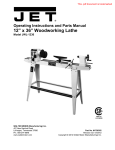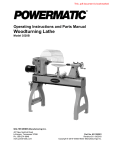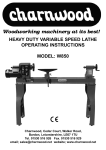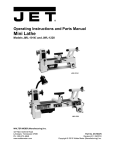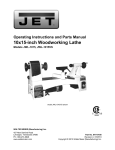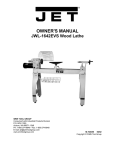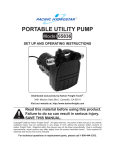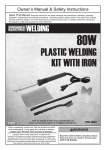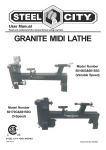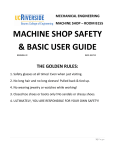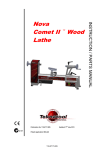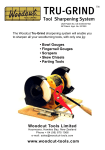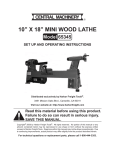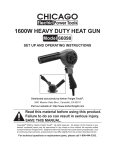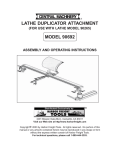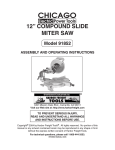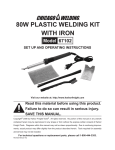Download Harbor Freight Tools 98676 User's Manual
Transcript
14” X 43” WOOD LATHE WITH STAND Model 98676 Set up And Operating Instructions Distributed exclusively by Harbor Freight Tools®. 3491 Mission Oaks Blvd., Camarillo, CA 93011 Visit our website at: http://www.harborfreight.com Read this material before using this product. Failure to do so can result in serious injury. Save this manual. Copyright© 2008 by Harbor Freight Tools®. All rights reserved. No portion of this manual or any artwork contained herein may be reproduced in any shape or form without the express written consent of Harbor Freight Tools. Diagrams within this manual may not be drawn proportionally. Due to continuing improvements, actual product may differ slightly from the product described herein. For technical questions or replacement parts, please call 1-800-444-3353. CONTENTS IMPORTANT SAFETY INFORMATION ......................................................3 GROUNDING ..............................................................................................7 EXTENSION CORDS ..................................................................................7 SYMBOLOGY .............................................................................................8 SPECIFICATIONS .......................................................................................8 UNPACKING ...............................................................................................9 ASSEMBLY INSTRUCTIONS .....................................................................9 WORK AREA SET UP ...............................................................................11 DEFINITION OF TERMS ...........................................................................11 ADJUSTMENTS ........................................................................................13 OPERATING INSTRUCTIONS ..................................................................13 MAINTENANCE AND SERVICING ...........................................................15 TROUBLESHOOTING ..............................................................................16 PARTS LIST ..............................................................................................17 PLEASE READ THE FOLLOWING CAREFULLY ....................................17 ASSEMBLY DIAGRAM .............................................................................18 WIRING DIAGRAM ...................................................................................19 WARRANTY INFORMATION ....................................................................19 SKU 98676 For technical questions, please call 1-800-444-3353. Page 2 Save This Manual NOTICE is used to address practices not related to personal injury. Keep this manual for the safety warnings and precautions, assembly, operating, inspection, maintenance and cleaning procedures. Write the product’s serial number in the back of the manual (or month and year of purchase if product has no number). Keep this manual and the receipt in a safe and dry place for future reference. CAUTION, without the safety alert symbol, is used to address practices not related to personal injury. General Power Tool Safety Warnings Important SAFETY Information WARNING Read all safety warnings and instructions. Failure to follow the warnings and instructions may result in electric shock, fire and/or serious injury. Save all warnings and instructions for future reference. The term ″power tool″ in the warnings refers to your mainsoperated (corded) power tool. In this manual, on the labeling, and all other information provided with this product: This is the safety alert symbol. It is used to alert you to potential personal injury hazards. Obey all safety messages that follow this symbol to avoid possible injury or death. 1. a.Keep work area clean and well lit. Cluttered or dark areas invite accidents. DANGER indicates a hazardous situation which, if not avoided, will result in death or serious injury. b.Do not operate power tools in explosive atmospheres, such as in the presence of flammable liquids, gases or dust. Power tools create sparks which may ignite the dust or fumes. WARNING indicates a hazardous situation which, if not avoided, could result in death or serious injury. CAUTION, used with the safety alert symbol, indicates a hazardous situation which, if not avoided, could result in minor or moderate injury. SKU 98676 Work area safety c.Keep children and bystanders away while operating a power tool. Distractions can cause you to lose control. 2. Electrical safety a.Power tool plugs must match the outlet. Never modify the plug in any way. Do not use any adapter plugs with grounded power tools. For technical questions, please call 1-800-444-3353. Page 3 c.Remove any adjusting key or wrench before turning the power tool on. A wrench or a key left attached to a rotating part of the power tool may result in personal injury. Unmodified plugs and matching outlets will reduce risk of electric shock. b.Avoid body contact with grounded surfaces such as pipes, radiators, ranges and refrigerators. There is an increased risk of electric shock if your body is grounded. d.Do not overreach. Keep proper footing and balance at all times. This enables better control of the power tool in unexpected situations. c.Do not expose power tools to rain or wet conditions. Water entering a power tool will increase the risk of electric shock. e.Dress properly. Do not wear loose clothing or jewelry. Keep your hair, clothing and gloves away from moving parts. Loose clothes, jewelry or long hair can be caught in moving parts. d.Do not abuse the cord. Never use the cord to unplug the power tool. Keep cord away from heat, oil, sharp edges or moving parts. Damaged or entangled cords increase the risk of electric shock. e.If operating a power tool in a damp location is unavoidable, use a Ground Fault Circuit Interrupter (GFCI) protected supply. Use of a GFCI reduces the risk of electric shock. 3. Personal safety a.Stay alert, watch what you are doing and use common sense when operating a power tool. Do not use a power tool while you are tired or under the influence of drugs, alcohol or medication. A moment of inattention while operating power tools may result in serious personal injury. b.Use safety equipment. Always wear ANSI-approved eye protection. Safety equipment such as NIOSH-approved dust mask/respirator, full face shield, heavy-duty work gloves, non-skid safety shoes, hard hat, or hearing protection used for appropriate conditions will reduce personal injuries. SKU 98676 f. If devices are provided for the connection of dust extraction and collection facilities, ensure these are connected and properly used. Use of these devices can reduce dust-related hazards. 4. Power tool use and care a.Do not force the power tool. Use the correct power tool for your application. The correct power tool will do the job better and safer at the rate for which it was designed. b.Do not use the power tool if the switch does not turn it on and off. Any power tool that cannot be controlled with the switch is dangerous and must be repaired. c.Disconnect the plug from the power source before making any adjustments, changing accessories, or storing power tools. Such preventive safety measures reduce the risk of starting the power tool accidentally. d.Store idle power tools out of the reach of children and do not allow persons unfamiliar with the power For technical questions, please call 1-800-444-3353. Page 4 tool or these instructions to operate the power tool. Power tools are dangerous in the hands of untrained users. e.Maintain power tools. Check for misalignment or binding of moving parts, breakage of parts and any other condition that may affect the power tool’s operation. If damaged, have the power tool repaired before use. Many accidents are caused by poorly maintained power tools. f. Keep cutting tools sharp and clean. Properly maintained cutting tools with sharp cutting edges are less likely to bind and are easier to control. g.Use the power tool, accessories and tool bits etc. in accordance with these instructions, taking into account the working conditions and the work to be performed. Use of the power tool for operations different from those intended could result in a hazardous situation. 6. Service a.Have your power tool serviced by a qualified repair person using only identical replacement parts. This will ensure that the safety of the power tool is maintained. Lathe Safety Warnings 1. 2. Maintain labels and nameplates on the Lathe. These carry important safety information. If unreadable or missing, contact Harbor Freight Tools for a replacement. Do not run the Lathe without its covers and guards in place. SKU 98676 3. Tighten all locks before operating. 4. Do not mount a split workpiece. 5. Use the lowest speed when starting a new workpiece. 6. Always stop the Lathe at its slowest speed. If the Lathe is run so fast that it vibrates, there is a risk that the workpiece will be thrown or the cutting tool jerked from your hands. 7. Always rotate the workpiece by hand before turning on the Lathe. If the workpiece strikes the tool rest, it could split and be thrown out of the Lathe. 8. Do not allow cutting tools to bite into the workpiece. The wood could be split or thrown from the Lathe. 9. Always position the tool rest above the centerline of the Lathe when shaping a piece of stock. 10. Before attaching a workpiece to the faceplate, always rough it out to make it as round as possible. This minimizes the vibrations while the piece is being turned. Always fasten the workpiece securely to the faceplate. Failure to do so could result in the workpiece being thrown away from the Lathe. 11. Remove all loose knots in the workpiece before mounting between the centers or on the faceplate. 12. Position your hands so they will not slip onto the workpiece when the Lathe is running. 13. Use a brush or compressed air to remove wood shavings; never your hands. The wood shavings will be sharp. For technical questions, please call 1-800-444-3353. Page 5 14. Avoid unintentional starting. Prepare to begin work before turning on the tool. 15. Do not reach across the Lathe while it is running. 16. Industrial applications must follow OSHA guidelines. 17. Do not use the Lathe if it is off-balance, or the workpiece is not properly centered. 18. Only feed workpiece into a cutting tool against the direction of rotation. The workpiece must always be rotating toward you. 19. Do not leave the tool unattended when it is plugged into an electrical outlet. Turn off the tool, and unplug it from its electrical outlet before leaving. 20. This product is not a toy. Keep it out of reach of children. 21. People with pacemakers should consult their physician(s) before use. Electromagnetic fields in close proximity to heart pacemaker could cause pacemaker interference or pacemaker failure. In addition, people with pacemakers should: • Avoid operating alone. • Do not use with power switch locked on. • Properly maintain and inspect to avoid electrical shock. • Any power cord must be properly grounded. Ground Fault Circuit Interrupter (GFCI) should also be implemented – it prevents sustained electrical shock. other construction activities, contains chemicals known [to the State of California] to cause cancer, birth defects or other reproductive harm. Some examples of these chemicals are: • Lead from lead-based paints • Crystalline silica from bricks and cement or other masonry products • Arsenic and chromium from chemically treated lumber Your risk from these exposures varies, depending on how often you do this type of work. To reduce your exposure to these chemicals: work in a well ventilated area, and work with approved safety equipment, such as those dust masks that are specially designed to filter out microscopic particles. (California Health & Safety Code § 25249.5, et seq.) 23. The warnings, precautions, and instructions discussed in this instruction manual cannot cover all possible conditions and situations that may occur. It must be understood by the operator that common sense and caution are factors which cannot be built into this product, but must be supplied by the operator. Save these instructions. 22. Some dust created by power sanding, sawing, grinding, drilling, and SKU 98676 For technical questions, please call 1-800-444-3353. Page 6 Grounding To prevent electric shock and death from incorrect grounding wire connection: Check with a qualified electrician if you are in doubt as to whether the outlet is properly grounded. Do not modify the power cord plug provided with the tool. Never remove the grounding prong from the plug. Do not use the tool if the power cord or plug is damaged. If damaged, have it repaired by a service facility before use. If the plug will not fit the outlet, have a proper outlet installed by a qualified electrician. of electric shock. (See 3-Prong Plug and Outlet.) 2. The grounding prong in the plug is connected through the green wire inside the cord to the grounding system in the tool. The green wire in the cord must be the only wire connected to the tool’s grounding system and must never be attached to an electrically “live” terminal. (See 3-Prong Plug and Outlet.) 3. The tool must be plugged into an appropriate outlet, properly installed and grounded in accordance with all codes and ordinances. The plug and outlet should look like those in the preceding illustration. (See 3-Prong Plug and Outlet.) Extension Cords Grounded Tools: Tools with Three 1. Grounded tools require a three wire Prong Plugs extension cord. Double Insulated tools can use either a two or three wire extension cord. This product uses a 3-prong plug. 2. As the distance from the supply outlet increases, you must use a heavier gauge extension cord. Using extension cords with inadequately sized wire causes a serious drop in voltage, resulting in loss of power and possible tool damage. (See Table A.) The smaller the gauge number of the wire, the greater the capacity of the cord. For example, a 14 gauge cord can carry a higher current than a 16 gauge cord. (See Table A.) 3. When using more than one extension cord to make up the total length, make sure each cord contains at 3-Prong Plug and Outlet 1. Tools marked with “Grounding Required” have a three wire cord and three prong grounding plug. The plug must be connected to a properly grounded outlet. If the tool should electrically malfunction or break down, grounding provides a low resistance path to carry electricity away from the user, reducing the risk SKU 98676 For technical questions, please call 1-800-444-3353. Page 7 4. 5. 6. 7. least the minimum wire size required. (See Table A.) Symbology If you are using one extension cord for more than one tool, add the nameplate amperes and use the sum to determine the required minimum cord size. (See Table A.) Double Insulated If you are using an extension cord outdoors, make sure it is marked with the suffix “W-A” (“W” in Canada) to indicate it is acceptable for outdoor use. Make sure the extension cord is properly wired and in good electrical condition. Always replace a damaged extension cord or have it repaired by a qualified electrician before using it. Protect the extension cords from sharp objects, excessive heat, and damp or wet areas. RECOMMENDED MINIMUM WIRE GAUGE FOR EXTENSION CORDS* (120/240 VOLT) (at full load) 50’ 75’ 100’ 150’ EXTENSION CORD LENGTH 25’ NAMEPLATE AMPERES 0 – 2.0 18 18 18 18 16 2.1 – 3.4 18 18 18 16 14 3.5 – 5.0 18 18 16 14 12 5.1 – 7.0 18 16 14 12 12 7.1 – 12.0 18 14 12 10 - 12.1 – 16.0 14 12 10 - - 16.1 – 20.0 12 10 - - - TABLE A * Based on limiting the line voltage drop to five volts at 150% of the rated amperes. SKU 98676 Canadian Standards Association Underwriters Laboratories, Inc. V~ A Volts Alternating Current Amperes No Load Revolutions per Minute n0 xxxx/min. (RPM) Specifications Electrical Requirements 120 V~ / 60 Hz Power Cord: 18 AWG X 3C 9.6 No Load Amps Lathe Type Wood Cutting Motor 1.0 HP Motor Speed 1720 RPM Spindle Speeds (RPM) 670, 840, 1040, 1230, 1480, 1650, 1770, 2100, 2420, 2900 Spindle Taper MT-2 Spindle Thread 1” Diameter x 8 TPI x 7/8” Long Headstock Adjustments Rotates at 0°, 60°, 90°, 120°, 180° Tail Stock Quill Travel 2-7/16” Tail Stock Quill Taper MT-2 Tool Rest Travel 1-7/16” Swing Over Bed 14-5/8” Drive Method Belt & Pulley Belt Type 0-625 V-Belt Accessories 3mm, 4mm, 6mm Hex Wrenches (1 ea.) Dead Center (Qty. 1) Faceplate (Qty. 1) Flat Wrenches (Qty. 2) Net Weight 282.2 Pounds For technical questions, please call 1-800-444-3353. Page 8 Unpacking 2. When unpacking, check to make sure that the item is intact and undamaged. If any parts are missing or broken, please call Harbor Freight Tools at the number shown on the cover of this manual as soon as possible. ASSEMBLY Instructions HEADSTOCK (1) Read the entire Important Safety Information section at the beginning of this manual including all text under subheadings therein before set up or use of this product. To prevent serious injury from accidental operation: Turn the Power Switch (71) of the Lathe to its “OFF” position and unplug the tool from its electrical outlet before assembling or making any adjustments. Place the Bed (38) assembly on the two Stand Legs (74, 78). Align the mounting holes in the Bed assembly with the mounting holes at the tops of the two Stand Legs. Secure the Bed assembly to the two Stand Legs using eight Screws (69), eight Spring Washers (75), and eight Nuts (33). Then set the Headstock (1) upon the Bed assembly. (See Figure A.) BED (38) STAND LEGS (74, 78) SCREWS (69) SPRING WASHERS (75) NUTS (33) Note: For additional information regarding the parts listed in the following pages, refer to the Assembly Diagram near the end of this manual. 1. NOTE: This product is very heavy (282.2 lb.). The following assembly procedures will require at least two additional personnel and a proper lifting device. SKU 98676 FIGURE A 3. To attach the Faceplate (2), use the Push Out Rod (22) and Wrench (47) to firmly thread the Faceplate onto the Spindle (4). To attach a workpiece to the Faceplate, use the four Flat Head Brass Wood Screws (83). (See Figures B below, and C next page.) WRENCH (47) PUSH OUT ROD (22) HEADSTOCK SPUR (3) FIGURE B FACEPLATE (2) For technical questions, please call 1-800-444-3353. Page 9 4. To use the Headstock Spur (3) and FIGURE C FACEPLATE (2) HEADSTOCK HOLE WOODSTOCK (NOT INCLUDED) TAILSTOCK HOLE PUSH OUT ROD (22) FLAT HEAD BRASS WOOD SCREWS (83) 4. TAILSTOCK SPUR (61) FIGURE E To install the Headstock Spur (3) and Tailstock Spur (61), remove the Faceplate (2) from the Headstock Spindle (4) using the Push Out Rod (22) and Wrench (47). Insert the Headstock Spur into the Spindle hole. then insert the Tailstock Spur into the Tailstock hole. To remove either the Headstock Spur or Tailstock Spur insert the Push Out Rod into the hole at the opposite end of the Headstock or Tailstock. (See Figures D and E.) FIGURE F DIGITAL READOUT (79) SCREWS (80) 6. The Lathe is now assembled. (See Figure G.) WRENCH (47) PUSH OUT ROD (22) HEADSTOCK SPUR (3) FIGURE G FIGURE D FACEPLATE (2) 5. To install the Digital Readout (79), use the two Screws (80). (See Figure F.) SKU 98676 For technical questions, please call 1-800-444-3353. Page 10 1. Work Area Set Up Designate a work area that is clean and well-lit. The work area must not allow access by children or pets to prevent injury and distraction. 2. The Lathe will need to be located on a surface capable of bearing the combined weight of the Lathe and intended workpieces. The surface must be able to withstand the vibration generated by the Lathe during operation. 3. The Lathe must be completely level, left-to-right and front-to-back, or the Lathe will not rotate properly and may become damaged. 4. The unpainted surfaces are coated with a waxy oil to protect them from corrosion during shipment. Remove the coating with a solvent cleaner or citrus-based degreaser. Avoid chlorine-based solvents since they will damage the paint. 5. Route the power cord along a safe route to reach the work area without creating a tripping hazard or exposing the power cord to possible damage. Definition of Terms Apron: The front part of the carriage assembly where the carriage handwheel is mounted. holding a workpiece by mounting it between the centers of the headstock and the tailstock spindles. Carriage: The assembly that moves the tool rest along the ways. Center: A precision ground tapered cylinder with a pointed tip and a Morse Taper shaft. Used in the tailstock to support the end of long workpieces. May also be used in the headstock spindle to support work between centers at both ends. Center Drill: A short drill used to form pilot holes and countersunk holes. Centerline: An imaginary line extending from the center of the spindle through the center of the tailstock ram, representing the central axis of the lathe around which the work rotates. Compound: Movable platform where the tool post is mounted; it can be set at an angle to the workpiece (also known as compound slide and compound rest). Compound Handwheel: The wheel used to move the compound slide in and out. Cross Slide Handwheel: The wheel used to move the cross slide in and out (also called cross feed). Bed: Main supporting casting running the length of the lathe Faceplate: A metal plate with a flat face-mounted spindle to hold irregularly shaped work. Between Centers: A dimension representing the maximum length of a workpiece that can be turned between centers. Also a method of Facing: A lathe operation in which wood is removed from the end of a workpiece to create a smooth surface. SKU 98676 For technical questions, please call 1-800-444-3353. Page 11 Gib: An adjustable length of steel or brass with a diamond shaped crosssection that engages one side of the dovetail slide. Used to adjust the dovetail for optimum tightness and to compensate for wear. Tailstock Handwheel: Moves the tailstock in and out. Has a tapered internal bore to accept a #2 Morse Taper shank. Tool Post: A device mounted on the compound that holds the cutting tool. Headstock: The main casting mounted on the left end of the bed where the spindle is mounted. Houses the spindle gears. Turning: A lathe operation that removes wood from the outside diameter of the workpiece. Ways: Surface along the top of the bed on which the saddle rides. The ways are aligned with the centerline of the lathe. Morse Taper (MT): A taper of specific dimensions used to mate matching male and female parts together tightly. The spindle has a #2 Morse Taper (MT-2) and the tailstock has a #2 Morse Taper (MT-2). Saddle: An “H” shaped casting that rides along the ways. A main component of the carriage. ADJUSTMENTS 1. Spindle: Main rotating shaft on which the chuck is mounted. It passes through the headstock. Spindle Through-hole: A dimension indicating the minimum diameter of the hole that passes through the spindle. A workpiece with a diameter smaller than this can pass through the spindle to work on longer pieces. Swing: A dimension representing the largest diameter workpiece that a lathe can rotate. The 14” x 43” Lathe has a 14-5/8” swing, meaning that the maximum size workpiece that can rotate without hitting the bed is 14-5/8” in diameter. Tailstock: Assembly that slides along the ways and can be locked in place. Used to hold long workpieces in place or to mount a drill chuck. SKU 98676 The Headstock (1) has five preset positions: • 0° setting for all spindle turning applications. • 60°, 90°, and 120° for use when making Faceplate turnings. • 180° for use when making Faceplate turnings when using the Extension Bed and Toolrest. 2. To set the Headstock (1) at the desired position, turn the Angular Setting Assembly (45) until you have completed at least one rotation. 3. Pull out the Eccentric Rod (25). Rotate the entire Headstock (1) clockwise to the desired position. The Headstock will be locked in position when it “clicks” into one of the five preset settings. Then retighten the Angular Setting Assembly (45). (See Figure H.) For technical questions, please call 1-800-444-3353. Page 12 FIGURE I FIGURE H ECCENTRIC ROD (25) ANGULAR SETTING ASSY. (45) POWER SWITCH (71) OPERATING INSTRUCTIONS 1. 2. The Lathe features a yellow Safety Switch on the Power Switch (71) to prevent unauthorized use. To turn the Lathe on, plug the Power Cord (76) into the nearest 120 volt, grounded, electrical outlet. Insert the Safety Switch into the Power Switch. Move the Power Switch to the “ON” position. To turn the Lathe off, move the Power Switch to the “OFF” position. To lock the Power Switch in the “OFF” position, remove the Safety Switch and store it in a safe location. (See Figure I.) SKU 98676 3. The Motor (13) of the Lathe must be running before you can use the Speed Control Lever (48-4). 4. The Speed Control Lever (48-4) can be turned to one of the ten fixed speeds (670, 840, 1040, 1230, 1480, 1650, 1770, 2100, 2420, 2900 RPM). 5. To set the speed, pull back on the Speed Control Lever (48-4) and rotate the Lever to the next fixed speed. Use the Speed Label (49) to choose the desired Lathe speed. 6. Turn the Speed Control Lever (48-4) clockwise to increase the speed, and turn the Lever counterclockwise to decrease the speed. 7. You must move the Speed Control Lever (48-4) to the lowest speed setting before turning the Power Switch (71) off. Otherwise, damage to the Lathe may occur. (See Figures J and K.) For technical questions, please call 1-800-444-3353. Page 13 TAILSTOCK SPINDLE (62) SPEED CONTROL LEVER (48-4) HANDLE ASSY. (64) HANDLE WHEEL (67) TAILSTOCK LOCK HANDLE (59) FIGURE J FIGURE K SPEED LABEL (49) FIGURE L 11. The Tool Rest (60) can be used with or without the Extension Tool Rest (58). (See Figure M, next page.) 8. 9. Loosen the Tailstock Lock Handle (59) to move the Tailstock (65). Push the Tailstock to the desired position on the Bed (38). Then retighten the Tailstock Lock Handle to lock the Tailstock in position. (See Figure L.) The Tailstock Spindle (62) can extend up to 2-7/16” from the Tailstock (65) housing. You can move the Tailstock Spindle (62) by loosening the Handle Assembly (64) and then turning the Handle Wheel (67). Make sure to retighten the Handle Assembly prior to turning on the Lathe. (See Figure L.) 12. To move the Tool Rest Body (56), loosen the Handle Assembly (57), and move the Body to the left or right and back or forth. Then retighten the Handle Assembly when the Tool Rest Body is in the desired position. (See Figure M, next page.) 13. When using the Extension Tool Rest (58), make the necessary adjustments using the two Handle Assemblies (57) to position the Tool Rest (60). (See Figure M, next page.) 14. Tighten the Handle Assemblies (57) and make sure there is adequate clearance between the workpiece and the Tool Rest assembly before turning on the Lathe. (See Figure M, next page.) 10. The Tailstock Spindle (62) is hollow and can be accessed from the Handle Wheel (67) end. Use the Push Out Rod (22) to remove the center cup or to drill holes through the center of a workpiece. (See Figure L.) SKU 98676 For technical questions, please call 1-800-444-3353. Page 14 To prevent serious injury from accidental operation: Turn the Power Switch (71) of the Lathe to its “OFF” position and unplug the tool from its electrical outlet before performing any inspection, maintenance, or cleaning procedures. TOOL REST (60) EXTENSION TOOL REST (58) HANDLE ASSY. (57) HANDLE ASSY. (57) TOOL REST BODY (56) FIGURE M HANDLE ASSY. (57) To prevent serious injury from tool failure: Do not use damaged equipment. If abnormal noise or vibration occurs, have the problem corrected before further use. 15. The Tool Rest (60) can also be repositioned to the Extension Tool Rest (58) for use on outboard turnings. (See Figure N.) 16. IMPORTANT: Make sure the Tool Rest (60) is adjusted as close to the workpiece as possible. Rotate the workpiece by hand to check clearance before turning on the Lathe. 1. BEFORE EACH USE, inspect the general condition of the Lathe. Check for loose screws, misalignment or binding of moving parts, cracked or broken parts, damaged electrical wiring, and any other condition that may affect its safe operation. 2. After Use, clean external surfaces of the tool with clean cloth. 3. DAILY, lubricate all external moving parts with ISO 68 or SAE 20W oil. 4. Lubricate the Tailstock oiling point every five uses, or once per week if used frequently. 5. WARNING! If the Power Cord (76) of this Lathe is damaged, it must be replaced only by a qualified service technician. TOOL REST (60) EXTENSION TOOL REST (58) FIGURE N Maintenance And Servicing Procedures not specifically explained in this manual must be performed only by a qualified technician. SKU 98676 For technical questions, please call 1-800-444-3353. Page 15 TROUBLESHOOTING Problem Possible Cause Possible Solution Quality of cut is poor. 1. Cutting tool is above workpiece center line. 2. Lathe speed too slow. 3. Cutting tool is dull. 4. Cutting too aggressively. 1. Lower cutting tool to center line of workpiece. 2. Increase lathe speed. 3. Sharpen or replace cutting tool. 4. Use a lighter touch. Excessive vibration when turning thin workpieces. 1. Cutting too aggressively. 1. Use a lighter touch. Excessive vibration when turning larger workpieces or bowls. 1. Headstock and/or tailstock improperly located at ends of workpiece. 2. Workpiece is unbalanced. 1. Check for proper workpiece centers. 1. Speed control lever not in its lowest speed setting. 1. Make sure speed control lever is turned to its lowest speed setting. 2. Make sure lathe is plugged into a working, 120 volt, grounded, electrical outlet. 3. Replace fuse or reset circuit breaker. Lathe will not turn on. 2. Electrical outlet not working or is of wrong voltage. 3. Blown fuse or tripped circuit breaker. Lathe will not turn off. 1. Damaged or faulty power switch and/or internal wiring. 2. Cut off stock until workpiece is balanced. 1. Unplug the lathe from its electrical outlet immediately. Do not operate lathe until it is repaired by a qualified service technician. Follow all safety precautions whenever diagnosing or servicing the Lathe. PLEASE READ THE FOLLOWING CAREFULLY The manufacturer and/or distributor has provided the parts list and assembly diagram in this manual as a reference tool only. Neither the manufacturer or distributor makes any representation or warranty of any kind to the buyer that he or she is qualified to make any repairs to the product, or that he or she is qualified to replace any parts of the product. In fact, the manufacturer and/or distributor expressly states that all repairs and parts replacements should be undertaken by certified and licensed technicians, and not by the buyer. The buyer assumes all risk and liability arising out of his or her repairs to the original product or replacement parts thereto, or arising out of his or her installation of replacement parts thereto. SKU 98676 For technical questions, please call 1-800-444-3353. Page 16 NO. DESCRIPTION PARTS LIST Q’TY NO. 1 HEADSTOCK 1 47 WRENCH DESCRIPTION Q’TY 1 2 FACEPLATE 1 48 GEAR ASSEMBLY 1 3 HEADSTOCK SPUR 1 48-1 SPRING BASE 1 4 SPINDLE 1 48-2 KNOB 1 5 KEY 1 48-3 BOLT 1 6 BEARING 2 48-4 SPEED CONTROL LEVER 1 7 "C"RING 2 48-5 SPRING--A 1 8 SPRING 1 48-6 SCREW 1 9 BRACKET-SHIFTING LEVER 1 48-7 PIN 1 10 "C"RING 1 48-8 SPRING--B 1 11 "C"RING 1 48-9 PLATE 1 12 "C"RING 1 48-10 GEAR 1 13 MOTOR 1 49 SPEED LABEL 1 14 KEY 1 50 INSTRUCTION MANUAL 1 15 SCREW 1 51 HEX SCREW 3 16 COVER-MOTOR 1 52 BACK 1 17 PULLEY-MOTOR(RIGHT) 1 53 BOLT-B 2 18 PULLEY-MOTOR(LEFT) 1 54 CLAMP-B 2 19 SPRING 1 55 ECCENTRIC ROD 1 20 SLEEVE 1 56 TOOL REST BODY 1 21 "C"RING 2 57 HANDLE ASSEMBLY 2 22 PUSH-OUT ROD 1 58 EXTENSION TOOL REST 1 23 KNOB 2 59 LOCK HANDLE-TAILSTOCK 1 24 "C"RING 3 60 TOOL REST 1 25 ECCENTRIC ROD 1 61 TAILSTOCK SPUR 1 26 SCREW 1 62 TAILSTOCK SPINDLE 1 27 "C"RING 1 63 TAIL STOCK SCREW 1 28 PULLEY-SPINDLE(LEFT) 1 64 HANDLE ASSEMBLY 1 29 V-BELT 1 65 TAILSTOCK 1 30 PULLEY-SPINDLE(RIGHT) 1 66 WASHER 1 31 BEARING 1 67 HANDLE WHEEL 1 32 NUT-LOCK 1 68 SCREW 1 33 NUT 9 69 SCREW 1 34 CLAMP 2 70 SWITCH BOX 1 35 NUT M4 2 71 SWITCH 1 36 "C"RING 1 73 SCREW 2 37 TURNING BASE 1 74 STAND LEG--I 1 38 BED 1 75 SPRING WASHER 8 39 BAFFLE 2 76 POWER CORD 1 40 SCREW 4 77 MOTOR POWER WIRE 1 41 HEX WRENCH 4 78 STAND LEG--II 1 42 BOLT-A 1 79 DIGITAL READOUT 1 43 CLAMP-A 1 80 SCREW 2 44 HEX NUT 3 81 SCREW 2 45 ANGULAR SETTING ASSEMBLY 1 82 BASE 1 46 SCREW 2 SKU 98676 For technical questions, please call 1-800-444-3353. Page 17 ASSEMBLY DIAGRAM SKU 98676 For technical questions, please call 1-800-444-3353. Page 18 WIRING DIAGRAM DIGITAL READOUT SWITCH SPINDLE SPEED SENSOR L MOTOR N PE Limited 1 year / 90 Day warranty Harbor Freight Tools Co. makes every effort to assure that its products meet high quality and durability standards, and warrants to the original purchaser that for a period of ninety days from date of purchase that the engine/motor, the belts (if so equipped), and the blades (if so equipped) are free of defects in materials and workmanship. Harbor Freight Tools also warrants to the original purchaser, for a period of one year from date of purchase, that all other parts and components of the product are free from defects in materials and workmanship (90 days if used by a professional contractor or if used as rental equipment). This warranty does not apply to damage due directly or indirectly, to misuse, abuse, negligence or accidents, repairs or alterations outside our facilities, normal wear and tear, or to lack of maintenance. We shall in no event be liable for death, injuries to persons or property, or for incidental, contingent, special or consequential damages arising from the use of our product. Some states do not allow the exclusion or limitation of incidental or consequential damages, so the above limitation of exclusion may not apply to you. This warranty is expressly in lieu of all other warranties, express or implied, including the warranties of merchantability and fitness. To take advantage of this warranty, the product or part must be returned to us with transportation charges prepaid. Proof of purchase date and an explanation of the complaint must accompany the merchandise. If our inspection verifies the defect, we will either repair or replace the product at our election or we may elect to refund the purchase price if we cannot readily and quickly provide you with a replacement. We will return repaired products at our expense, but if we determine there is no defect, or that the defect resulted from causes not within the scope of our warranty, then you must bear the cost of returning the product. This warranty gives you specific legal rights and you may also have other rights which vary from state to state. 3491 Mission Oaks Blvd. • PO Box 6009 • Camarillo, CA 93011 • (800) 444-3353 Record Product’s Serial Number Here: Note:If product has no serial number, record month and year of purchase instead. Note:Some parts are listed and shown for illustration purposes only, and are not available individually as replacement parts. SKU 98676 For technical questions, please call 1-800-444-3353. Page 19



















